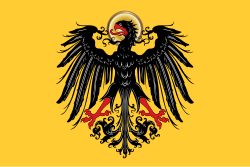Durynské vévodství
| Durynské vévodství (lankrabství) Herzogtum (Landgrafschaft) Thüringen
| |||||||||||
Geografie
| |||||||||||
| Obyvatelstvo | |||||||||||
| Státní útvar | |||||||||||
feudální dědičná monarchie | |||||||||||
| Státní útvary a území | |||||||||||
| |||||||||||
Durynské vévodství (německy Herzogtum Thüringen) byl středověký stát Svaté říše římské. Původně bylo vévodstvím Franské říše a východně položenou markou Austrasie v době panování dynastie Merovejců. Název byl odvozen od místního germánského kmene Durynků (latinsky Thuringi), kteří zde v polovině 5. století, zhruba na území přibližně odpovídajícím dnešnímu Durynsku, vybudovali vlastní samostatnou říši (kmenové království). V průběhu středověku ubývalo vévodství co do rozlohy i významu, až nakonec bylo v roce 1130 pozměněno na lankrabství (německy Landgrafschaft Thüringen).
Historie


Kmenové království Durynků, které se utvářelo v průběhu 5. století, bylo roku 531 vyvráceno Franky. Na jeho místě Frankové vytvořili Durynské vévodství, roku 1130 pozměněné na Durynské lankrabství, které přetrvalo do roku 1440. Během války o durynské dědictví se od Durynského lankrabství oddělila část, na níž roku 1264 vzniklo Hesenské lankrabství. Od roku 1572 až do 19. století byla zvláště jižní polovina Durynska rozdělena mezi řadu různě velkých států a státečků (tzv. ernestinská vévodství a hrabství rodů Reussů a Schwarzburgů). Některé z nich zanikly začátkem 19. století, jiné se roku 1871 změnily ve spolkové země Německého císařství.
Odkazy
Reference
Související články
Externí odkazy
 Obrázky, zvuky či videa k tématu Durynské vévodství na Wikimedia Commons
Obrázky, zvuky či videa k tématu Durynské vévodství na Wikimedia Commons
Média použitá na této stránce
No official flag.
Autor: Dragovit, Licence: CC BY-SA 4.0
Red Oriflamme standard attributed to the Byzantine emperor Constantine VI on the Triclinum mosaic. According to eleventh-century ballad the Chanson de Roland, the oriflamme was a royal banner of Charlemagne, first called Romaine and then Montjoie. Nothing is known about its use by the Byzantine emperor Constantine VI or others.
Autor: MostEpic, Licence: CC BY-SA 4.0
Coat of arms of the house of Hesse
Ducal Banner of Saxony since the 14th-century Royal Standard of the Kingdom of Saxony (1806-1918)
Autor: J a1, Licence: CC BY-SA 3.0
Banner of knights from Braunschweig in battle of Grunwald (1410) identical in appearance with the former coat of arms of Thuringia.
Autor: Alphathon /ˈæɫfə.θɒn/ (talk), Licence: CC BY-SA 4.0
A map of the Landgraviate of Thuringia (German: Landgrafschaft Thüringen) at the time of the Hohenstaufen Emperors (circa 1250). Note that while it uses the same scheme as standard location/locator maps, this map technically does not conform to the standard, as it is not in equirectangular projection. Therefore grid lines for latitude and longitude are also included.
Autor: Sémhur, Licence: CC BY-SA 3.0
Map of the rise of Frankish Empire, from 481 to 814.
Autor: Dragovit, Licence: CC BY-SA 4.0
The green Oriflamme standard attributed to Charlemagne according to the 9th century mosaic where is Charlemagne with the Pope Leo II in the San Giovanni church, Rome. According to 11th century ballad the Chanson de Roland, the oriflamme was a royal banner of Charlemagne, first called Romaine and then Montjoie.
Anachronistic representation of the royal banner of the 12th(?) or 13th to early 15th centuries.
The banner of this period would be square in shape, and the eagle would not have a halo.
The black eagle in a golden field was the ensign of the German kings (as opposed to the emperor) in the 12th and 13th century, but in the 14th century, it was gradually re-interpreted as representing the empire. An early reference to such a banner as "imperial" is made in an account of the burial of Charles IV (d. 1378), as der schwartz adler des richs in einem guldin veld .Autor: Simsunman, Licence: CC BY-SA 4.0
Peter Heß: Blätter zur Landeskunde. Landeszentrale für politische Bildung Thüringen, 8. Auflage 2005.
„Das Wappen mit dem bunten Löwen erscheint erstmals unter Landgraf Hermann I. (1190–1217) aus dem Geschlecht der Ludowinger. [...] Im Ergebnis des von 1247 bis 1263 währenden Erbfolgestreits kam es schließlich zur endgültigen Trennung zwischen Thüringen und Hessen, doch behielten sowohl die Wettiner, als auch die hessischen Erben [...] das Wappen mit dem bunten Löwen bei. [...] Die Frage nach dem Ursprung der doch recht ungewöhnlichen Streifung des Löwen lässt sich nicht beantworten. [...] Mit Sicherheit sind Rot und Weiß die Mainzer Farben, die bei Adligen, die in enger Verbindung zum Erzbistum Mainz standen, oft zu finden sind.“
Beschreibung: Vollwappen des Wettiner Landgrafen Albrecht II. von Thüringen um 1265
Quelle: http://www.lzt-thueringen.de/files/andeswappen.pdf












